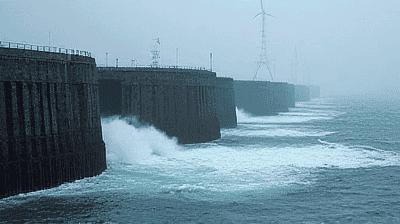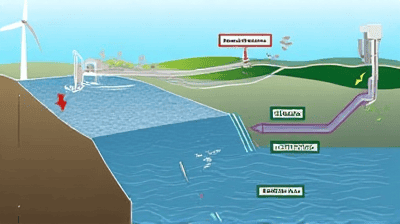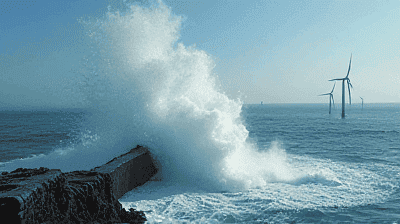
In the face of climate change and the urgent need for sustainable energy solutions, tidal energy has emerged as a promising yet underutilized resource. Harnessing the kinetic and potential energy of ocean tides presents an opportunity to tap into a reliable source of renewable energy that can contribute to the global transition away from fossil fuels.
Tidal energy is derived from the gravitational pull of the moon and the sun on Earth's waters, leading to periodic changes in sea levels. These changes create tidal currents, which can be harnessed to generate electricity. Tidal energy can be classified into two main types:
Tidal Streams: This involves capturing the kinetic energy of moving water in tidal currents using underwater turbines.
Tidal Barrages: This method uses the potential energy created by the difference in water levels between high and low tides, typically involving a dam-like structure built across the entrance of an estuary.
The tides are primarily influenced by the gravitational forces exerted by the moon and the sun, along with the Earth's rotation. As these celestial bodies exert their pull, they cause water to rise and fall, creating high and low tides, which occur approximately every six hours. This cyclical pattern allows for predictable energy generation, distinguishing tidal energy from other renewable sources such as solar and wind energy.

Tidal energy offers several significant advantages that position it as a crucial component of the renewable energy landscape:
Unlike solar and wind energy, tidal energy is highly predictable due to the regular and cyclical nature of tides. This predictability allows energy producers to generate forecasts for tidal energy production well in advance, making it easier to integrate it into existing energy grids.
Tidal energy systems typically have a lower environmental footprint compared to fossil fuel extraction and some other renewable energy methods. Tidal barrages can have impacts on marine ecosystems, but they generate clean energy without emissions, contributing to reduced greenhouse gas emissions.
The world’s oceans have vast potential for energy generation through tidal systems. Estimates suggest that the global potential for tidal energy could reach several hundred gigawatts, enough to power millions of homes.
Once constructed, tidal energy installations generally require less maintenance than wind or solar systems. Many tidal turbines are designed to last for decades, providing reliable energy over long periods without the need for frequent repairs.
Several technologies have been developed to harness tidal energy effectively. The two primary approaches are tidal stream systems and tidal barrage systems, which employ different methods to capture energy from the tides.
Tidal stream systems utilize underwater turbines that capture the kinetic energy of fast-moving water currents. These turbines are similar in principle to wind turbines and can operate efficiently in various marine environments. Key examples include:
Horizontal Axis Turbines: These turbines rotate around a horizontal axis, capturing energy from the flowing water as it passes over them. They can be installed on the seabed or on floating platforms.
Vertical Axis Turbines: These turbines rotate around a vertical axis and can capture energy from currents approaching from any direction, making them versatile for different tidal conditions.
Tidal barrage systems rely on the difference in water levels between high and low tides. They consist of a dam-like structure built across an estuary, with sluice gates that allow water to flow in and out. When high tide occurs, water is trapped behind the barrage. As the tide recedes, the water flows back to the sea through turbines, generating electricity. Notable examples include:
La Rance Tidal Power Station: Located in France, this facility has been operational since 1966 and utilizes tidal barrage technology to generate renewable energy.
Sihwa Lake Tidal Power Station: Situated in South Korea, this project has adapted a tidal barrage system to generate significant amounts of electricity from tidal movements.

As countries prioritize renewable energy sources, various nations are investing in tidal energy initiatives. Here are some notable projects and developments around the globe:
The UK is a leader in tidal energy research and development. The Pentland Firth and Orkney Waters are areas with significant potential, hosting several tidal stream projects, including:
Canada has vast coastlines and opportunities for tidal energy generation, particularly in regions like the Bay of Fundy. Notable projects include:
Countries in the Asia-Pacific region are also recognizing the potential of tidal energy:
China: With extensive coastal areas, China is exploring tidal energy systems, including tidal barrage projects, to enhance its renewable energy capacity.
South Korea: Building on the success of the Sihwa Lake tidal power station, South Korea is investigating further developments in tidal energy.
Despite its promise, tidal energy faces several challenges that hinder its widespread implementation:
The construction of tidal energy facilities, particularly tidal barrages, requires significant upfront investment. These costs can deter potential investors and impede the development of new projects.
While tidal energy has a lower environmental impact compared to fossil fuels, tidal barrages can alter local ecosystems, impacting marine life and sediment transport. Conducting thorough environmental impact assessments is essential to address these concerns.
The successful deployment of tidal energy relies on specific geographical features, such as strong tidal currents and suitable coastline configurations. This limitation restricts the number of feasible sites for tidal energy installations.
Tidal energy technology is still in a relatively early stage of development compared to wind and solar energy. Continued research and innovation are required to optimize efficiency, reduce costs, and enhance the technology.
The development of tidal energy projects often faces regulatory hurdles, including permitting processes and interconnection with existing electricity grids. Establishing supportive policies and frameworks can facilitate the growth of tidal energy.

As research into tidal energy continues, advancements in technology will play a crucial role in improving efficiency and reducing costs. Innovations may include:
Enhanced Turbine Designs: Developing advanced turbine designs that can capture more energy from tidal currents while minimizing environmental impacts.
Energy Storage Solutions: Integrating tidal energy with energy storage systems to ensure a more stable and reliable power supply.
Tidal energy can complement other renewable sources, creating a diversified energy portfolio. Integrating tidal energy with offshore wind, solar, and wave energy can enhance grid stability and reduce reliance on fossil fuels.
International cooperation in research, investment, and knowledge sharing will be crucial for advancing tidal energy technologies. Collaborating on large-scale projects can lead to economies of scale, driving down costs and expanding deployment.
To unlock the full potential of tidal energy, governments must establish supportive policies and incentives that encourage investment and development. This includes streamlining permitting processes, providing financial support, and promoting research initiatives.
Tidal energy holds immense promise as a reliable and sustainable source of power capable of helping to transition the world to clean energy. By harnessing the kinetic and potential energy of ocean currents, tidal energy can provide consistent energy generation while reducing greenhouse gas emissions.
While there are challenges to overcome, the advantages of tidal energy, including its predictability and low environmental impact, make it a valuable component of the renewable energy landscape. With continued technological advancements, supportive policies, and global collaboration, tidal energy can become a significant player in the global shift toward sustainable energy sources.
As we look to the future, embracing tidal energy may be one of the essential steps toward achieving a cleaner, greener planet, ensuring energy security, and combating climate change for generations to come.